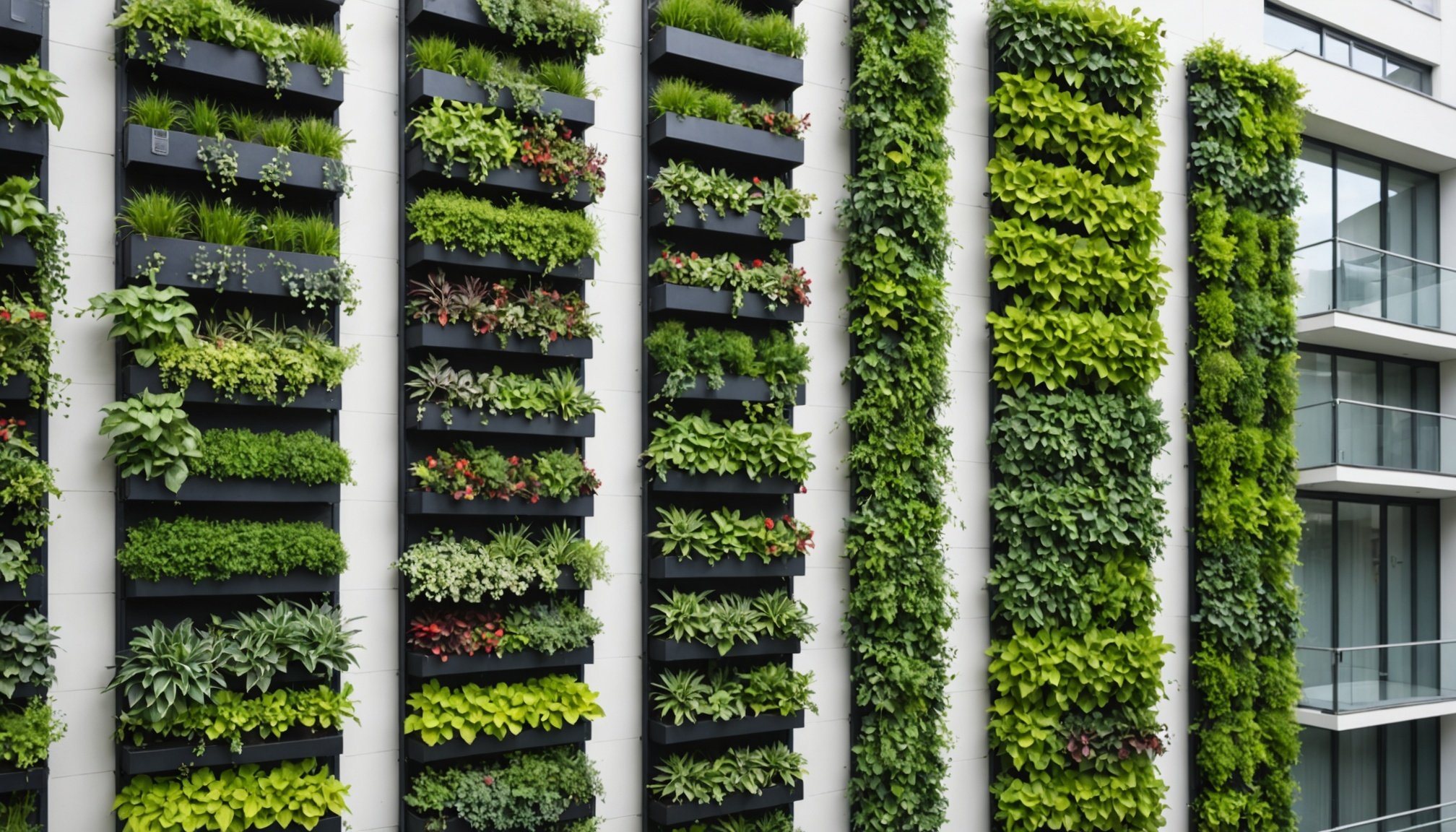Overview of Vertical Gardening
Vertical gardening revolutionises the way urban residents approach plant cultivation by maximising available space. This method transforms walls and small areas into lush, vibrant green spaces, offering an ideal solution for those residing in confined environments. Vertical gardening involves growing plants in upward displays rather than traditional horizontal setups, enabling efficient use of limited areas.
For urban gardening enthusiasts and those faced with space constraints, adopting vertical gardening not only facilitates the beautification of dull spaces but also contributes to improved air quality and general well-being. The primary benefit includes enhanced space optimization, allowing for the cultivation of a diverse range of plants without the need for expansive land.
In the same genre : Essential Tips for UK Homeowners: Safeguarding and Optimizing Your Home”s Electrical Wiring
Popular techniques involve structures such as trellises, wall planters, and stacked containers. These systems support various plants, from ornamental species to vegetables, accommodating the preferences of beginner and seasoned gardeners alike. Utilizing these techniques ensures the integration of greenery into urban environments, which otherwise lack sufficient gardening areas.
By incorporating these innovative approaches, urban dwellers can experience the joys of gardening without the necessity of a traditional backyard. Thus, vertical gardening not only addresses the practical challenges posed by city living but also encourages sustainable and environmentally friendly practices, enriching both personal and communal spaces.
In the same genre : Finding the Perfect Mattress for UK Weather: Your Ultimate Guide to Comfort and Adaptability
Creative Vertical Garden Designs for Flats
In the bustling city life, flats might seem to limit one’s gardening aspirations, but creative gardening solutions abound for those eager to bring greenery into tight spaces. Vertical installations transform any flat’s dull wall or balcony into a thriving mini-ecosystem. Here, simple yet unique design ideas like wall-mounted planters, trellises, and pocket gardens play a starring role, adding vibrancy without consuming crucial living space.
Wall-mounted planters are a popular choice for their sleek appearance and functionality. They provide a structured layout that can accommodate herbs, flowers, or even vegetables, enhancing the aesthetic of any area. Trellises offer an engaging dimension by supporting climbing plants, bringing nature to otherwise unused wall space. Meanwhile, pocket gardens—small fabric or felt pockets that attach to walls—offer surprising depth and diversity, able to hold a variety of plants, including succulents and ferns.
For those who might feel intimidated by DIY projects, vertical gardening kits provide an innovative structure ready for easy setup. Such kits can include everything from mounting equipment to self-watering systems, making them ideal for beginner gardeners. With these tools at hand, anyone can embrace the green revolution and transform their flat into a refreshing slice of nature.
Suitable Plants for Vertical Gardens in the UK
In the realm of plant selection for vertical gardens, choosing the right varieties can make all the difference. The UK climate is a key consideration when determining the best plants for your garden. With its temperate maritime climate, selecting plants that can thrive in limited spaces and in the specific light conditions your garden offers is crucial.
Herbs such as thyme, mint, and parsley are excellent choices. They are not only compact, saving space, but they also thrive in varying light conditions, making them versatile options for UK gardens. Succulents, known for their low maintenance, are ideal for indoor vertical gardens that receive ample indirect light. Their water-retention abilities enable them to survive longer dry spells, perfect for vertical setups.
For trailing plants, consider English ivy or trailing lobelia. They cascade beautifully, adding depth and interest to your vertical garden layout. Their ability to adapt to different climates enhances their suitability for the UK’s unpredictable weather. Seasonal tips are also essential to maintain a lush garden throughout the year. Spring is a great time for planting hardy trailing plants, while herbs can be planted in summer to ensure they catch enough sunlight for growth.
Making informed decisions on plant selection based on these guidelines will help sustain a vibrant and flourishing vertical garden in the UK.
DIY Instructions for Building Vertical Gardens
Embarking on a DIY gardening project like a vertical garden can be an exciting way to enhance your space. The initial step involves gathering basic tools and materials. Essential items include a wooden pallet or a frame, landscape fabric, a staple gun, soil, and the plants of your choice. Ensuring you have these materials at hand will streamline the process.
Step-by-step Guide
- Prepare the Structure: Start by securing the landscape fabric to the back and sides of the frame with the staple gun. This creates a pocket for holding the soil.
- Add Soil: Fill each pocket carefully with soil, ensuring an even distribution for plant roots to thrive.
- Plant Selection and Placement: Choose plants suitable for vertical growth, such as herbs or succulents, and place them in the soil pockets. Align plants according to their light and water needs.
Common Mistakes to Avoid
While building your own garden, avoid overwatering as this can lead to root rot. Ensure your structure is sturdy enough to hold the weight of soil and plants. Lastly, avoid placing your vertical garden in areas without adequate sunlight, as this can stunt plant growth. Remember, thoughtful planning and careful execution are key to a flourishing vertical garden.
Space-Saving Techniques for Urban Living
In densely populated urban areas, making the most of limited space can be a challenge. Space-saving solutions such as vertical gardening offer innovative ways to efficiently use small outdoor areas. This approach enables residents to cultivate plants by growing them upwards rather than outwards, making it a perfect strategy for maximizing space.
Vertical gardens can easily be integrated into balconies or patios, transforming them into lush, green sanctuaries. Even in apartments without outdoor spaces, this technique can be adapted inside by using living walls or compact planters. They’re not just practical but also add an aesthetic touch to urban homes.
To create these vertical gardens, shelving units can serve as excellent structures for small garden ideas. Trellises not only support climbing plants but also orient the garden vertically. Incorporating multi-functional furniture, like benches with planter space, optimizes the use of any available area, combining the garden with everyday living needs.
These combined methods ensure efficient gardening becomes accessible even in the most space-restricted environments. Whether you choose to embellish a cozy urban balcony or a tiny indoor alcove, the possibilities are only limited by imagination and a bit of ingenuity with space-saving techniques.
Best Materials for Vertical Gardening Structures
Selecting the right gardening materials is crucial to building sturdy and enduring vertical garden structures. For DIY enthusiasts looking to explore this, wood remains a classic choice due to its natural appearance and versatility. It’s vital, however, to ensure the wood is treated to withstand moisture, enhancing its longevity.
Metal offers a contemporary look and is remarkably durable, making it a popular option. Metal structures should be properly coated or galvanized to prevent rust, especially in humid conditions. Utilizing metal ensures less maintenance with a modern aesthetic.
Recycled materials present an innovative and eco-friendly option, contributing to sustainable gardening practices. Repurposed items such as pallets, plastic bottles, or old pipes can form unique and functional garden setups. These sustainable choices not only reduce waste but can also be cost-effective.
When constructing vertical gardens, consider water drainage and soil. Proper drainage prevents root rot and encourages healthy plant growth. Ensure materials are arranged to facilitate the natural flow of water. Also, select a substrate that holds moisture without drowning the roots, maintaining a balance for optimal plant health. Adopting an eco-friendly mindset extends beyond materials, integrating thoughtful gardening practices to support sustainability from the ground up.
Maintaining Your Vertical Garden
Effective garden maintenance is crucial for a flourishing vertical garden. Urban gardeners often face challenges due to limited space, making efficient watering systems essential. Drip irrigation is a popular choice as it delivers water directly to plants’ roots, conserving water and ensuring optimal growth. Self-watering pots are also beneficial, especially for those with a busy lifestyle. These systems help maintain the soil’s moisture level without frequent manual watering.
Plant care in vertical gardens involves understanding the specific needs of your plants. Regularly inspect plants for pests, as vertical gardens can sometimes be more susceptible to infestations. Using natural pest control methods, such as neem oil or introducing beneficial insects, can help manage these issues.
When it comes to pruning, it’s important to remove dead or dying foliage to encourage new growth. This practice not only maintains the plant’s health but also keeps your garden visually appealing. Seasonal adjustments, like moving plants indoors during cold spells or providing shade in intense heat, are vital for optimal growth.
Lastly, urban settings can impact air flow and light exposure. Monitor these conditions to ensure your vertical garden thrives year-round. Adapt maintenance techniques to enhance air circulation and maximize light exposure for the best results.
Successful Vertical Garden Installations
In recent years, vertical gardens have gained popularity, particularly in urban environments like UK flats, turning them into vibrant spaces. Real-life examples serve as a powerful inspiration for many budding gardeners.
One standout case study features a London flat where a small balcony was transformed into a lush vertical oasis. With limited horizontal space, the owner installed a series of tiered planters. The success of this garden hinged on selecting plants that thrived in partial sunlight—a crucial factor noted by the gardener, who shared their journey in a heartfelt interview.
An analysis of successful vertical gardens often reveals common elements that contribute to their efficacy. For example, selecting the right plants, considering sunlight exposure, and maintaining a consistent watering schedule are paramount. One urban gardener remarked how using drip irrigation significantly enhanced the health and growth of their plants.
Innovative designs have incorporated sustainable practices, such as using recycled materials for planter construction. These practices do not only offer environmental benefits but also endow the gardens with a unique, personalized touch. The stories of successful installations provide both practical insights and encouragement for those considering similar projects, reinforcing how creativity can flourish even in the most confined of spaces.











